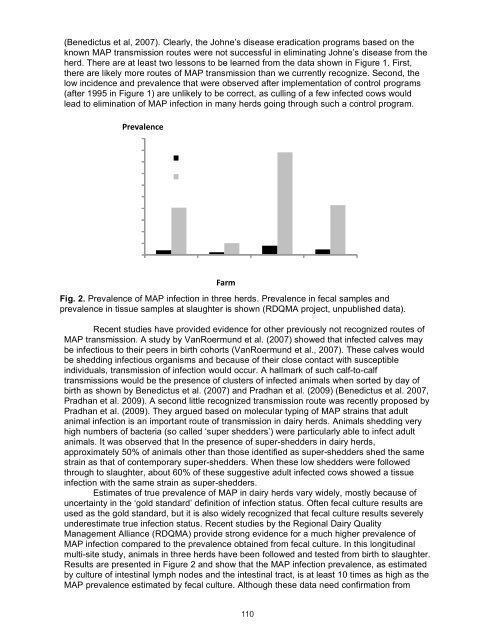Proceedings of the 10th International Colloquium on Paratuberculosis
Proceedings of the 10th International Colloquium on Paratuberculosis
Proceedings of the 10th International Colloquium on Paratuberculosis
Create successful ePaper yourself
Turn your PDF publications into a flip-book with our unique Google optimized e-Paper software.
(Benedictus et al, 2007). Clearly, <str<strong>on</strong>g>the</str<strong>on</strong>g> Johne’s disease eradicati<strong>on</strong> programs based <strong>on</strong> <str<strong>on</strong>g>the</str<strong>on</strong>g><br />
known MAP transmissi<strong>on</strong> routes were not successful in eliminating Johne’s disease from <str<strong>on</strong>g>the</str<strong>on</strong>g><br />
herd. There are at least two less<strong>on</strong>s to be learned from <str<strong>on</strong>g>the</str<strong>on</strong>g> data shown in Figure 1. First,<br />
<str<strong>on</strong>g>the</str<strong>on</strong>g>re are likely more routes <str<strong>on</strong>g>of</str<strong>on</strong>g> MAP transmissi<strong>on</strong> than we currently recognize. Sec<strong>on</strong>d, <str<strong>on</strong>g>the</str<strong>on</strong>g><br />
low incidence and prevalence that were observed after implementati<strong>on</strong> <str<strong>on</strong>g>of</str<strong>on</strong>g> c<strong>on</strong>trol programs<br />
(after 1995 in Figure 1) are unlikely to be correct, as culling <str<strong>on</strong>g>of</str<strong>on</strong>g> a few infected cows would<br />
lead to eliminati<strong>on</strong> <str<strong>on</strong>g>of</str<strong>on</strong>g> MAP infecti<strong>on</strong> in many herds going through such a c<strong>on</strong>trol program.<br />
����������<br />
����<br />
Fig. 2. Prevalence <str<strong>on</strong>g>of</str<strong>on</strong>g> MAP infecti<strong>on</strong> in three herds. Prevalence in fecal samples and<br />
prevalence in tissue samples at slaughter is shown (RDQMA project, unpublished data).<br />
Recent studies have provided evidence for o<str<strong>on</strong>g>the</str<strong>on</strong>g>r previously not recognized routes <str<strong>on</strong>g>of</str<strong>on</strong>g><br />
MAP transmissi<strong>on</strong>. A study by VanRoermund et al. (2007) showed that infected calves may<br />
be infectious to <str<strong>on</strong>g>the</str<strong>on</strong>g>ir peers in birth cohorts (VanRoermund et al., 2007). These calves would<br />
be shedding infectious organisms and because <str<strong>on</strong>g>of</str<strong>on</strong>g> <str<strong>on</strong>g>the</str<strong>on</strong>g>ir close c<strong>on</strong>tact with susceptible<br />
individuals, transmissi<strong>on</strong> <str<strong>on</strong>g>of</str<strong>on</strong>g> infecti<strong>on</strong> would occur. A hallmark <str<strong>on</strong>g>of</str<strong>on</strong>g> such calf-to-calf<br />
transmissi<strong>on</strong>s would be <str<strong>on</strong>g>the</str<strong>on</strong>g> presence <str<strong>on</strong>g>of</str<strong>on</strong>g> clusters <str<strong>on</strong>g>of</str<strong>on</strong>g> infected animals when sorted by day <str<strong>on</strong>g>of</str<strong>on</strong>g><br />
birth as shown by Benedictus et al. (2007) and Pradhan et al. (2009) (Benedictus et al. 2007,<br />
Pradhan et al. 2009). A sec<strong>on</strong>d little recognized transmissi<strong>on</strong> route was recently proposed by<br />
Pradhan et al. (2009). They argued based <strong>on</strong> molecular typing <str<strong>on</strong>g>of</str<strong>on</strong>g> MAP strains that adult<br />
animal infecti<strong>on</strong> is an important route <str<strong>on</strong>g>of</str<strong>on</strong>g> transmissi<strong>on</strong> in dairy herds. Animals shedding very<br />
high numbers <str<strong>on</strong>g>of</str<strong>on</strong>g> bacteria (so called ‘super shedders’) were particularly able to infect adult<br />
animals. It was observed that In <str<strong>on</strong>g>the</str<strong>on</strong>g> presence <str<strong>on</strong>g>of</str<strong>on</strong>g> super-shedders in dairy herds,<br />
approximately 50% <str<strong>on</strong>g>of</str<strong>on</strong>g> animals o<str<strong>on</strong>g>the</str<strong>on</strong>g>r than those identified as super-shedders shed <str<strong>on</strong>g>the</str<strong>on</strong>g> same<br />
strain as that <str<strong>on</strong>g>of</str<strong>on</strong>g> c<strong>on</strong>temporary super-shedders. When <str<strong>on</strong>g>the</str<strong>on</strong>g>se low shedders were followed<br />
through to slaughter, about 60% <str<strong>on</strong>g>of</str<strong>on</strong>g> <str<strong>on</strong>g>the</str<strong>on</strong>g>se suggestive adult infected cows showed a tissue<br />
infecti<strong>on</strong> with <str<strong>on</strong>g>the</str<strong>on</strong>g> same strain as super-shedders.<br />
Estimates <str<strong>on</strong>g>of</str<strong>on</strong>g> true prevalence <str<strong>on</strong>g>of</str<strong>on</strong>g> MAP in dairy herds vary widely, mostly because <str<strong>on</strong>g>of</str<strong>on</strong>g><br />
uncertainty in <str<strong>on</strong>g>the</str<strong>on</strong>g> ‘gold standard’ definiti<strong>on</strong> <str<strong>on</strong>g>of</str<strong>on</strong>g> infecti<strong>on</strong> status. Often fecal culture results are<br />
used as <str<strong>on</strong>g>the</str<strong>on</strong>g> gold standard, but it is also widely recognized that fecal culture results severely<br />
underestimate true infecti<strong>on</strong> status. Recent studies by <str<strong>on</strong>g>the</str<strong>on</strong>g> Regi<strong>on</strong>al Dairy Quality<br />
Management Alliance (RDQMA) provide str<strong>on</strong>g evidence for a much higher prevalence <str<strong>on</strong>g>of</str<strong>on</strong>g><br />
MAP infecti<strong>on</strong> compared to <str<strong>on</strong>g>the</str<strong>on</strong>g> prevalence obtained from fecal culture. In this l<strong>on</strong>gitudinal<br />
multi-site study, animals in three herds have been followed and tested from birth to slaughter.<br />
Results are presented in Figure 2 and show that <str<strong>on</strong>g>the</str<strong>on</strong>g> MAP infecti<strong>on</strong> prevalence, as estimated<br />
by culture <str<strong>on</strong>g>of</str<strong>on</strong>g> intestinal lymph nodes and <str<strong>on</strong>g>the</str<strong>on</strong>g> intestinal tract, is at least 10 times as high as <str<strong>on</strong>g>the</str<strong>on</strong>g><br />
MAP prevalence estimated by fecal culture. Although <str<strong>on</strong>g>the</str<strong>on</strong>g>se data need c<strong>on</strong>firmati<strong>on</strong> from<br />
110






